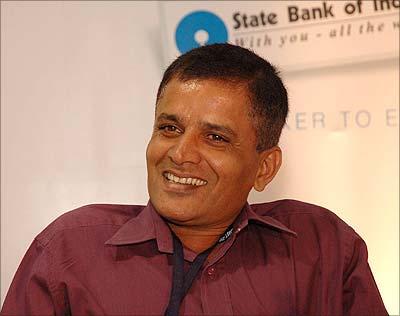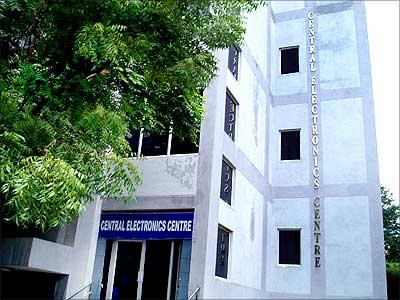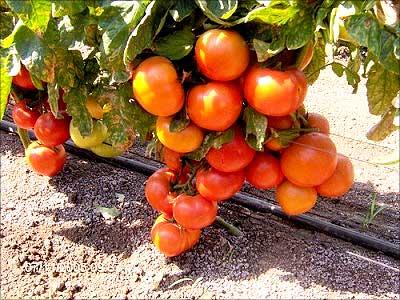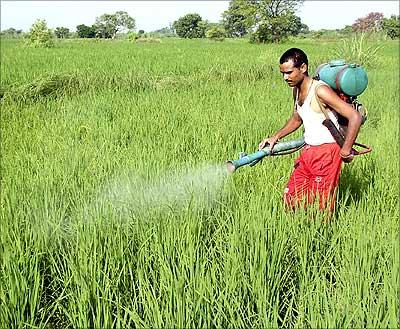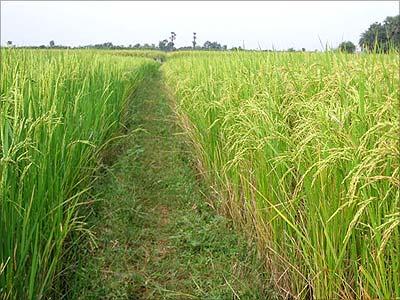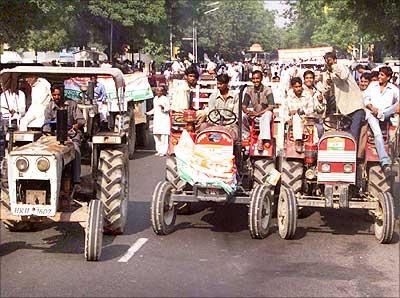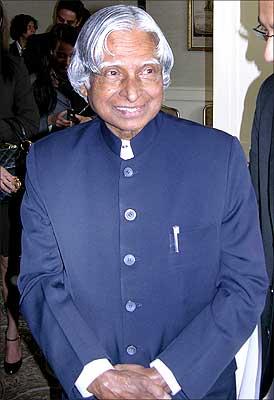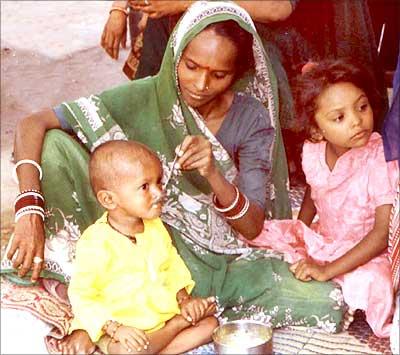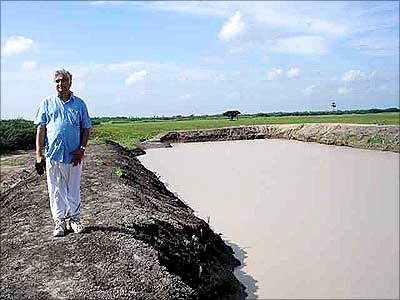
It was Pongal with a difference for Ram Krishnan, an alumnus of the Indian Institute of Technology - Madras, who spent it in Vilathikulam, a village in Tamil Nadu.
Vilathikulam in Ramanathapuram district is one of the driest regions in the state. On an average, it receives only nine days of rainfall in a year.
But the parched village has seven million litres of water in three ponds today, thanks to Krishnan's efforts.
His involvement with Vilathikulam started four years ago. Today, the villagers are like his family. In fact, he had invited many of them to the Pan IIT conference in Chennai in December and also arranged rural visits for the alumni, hoping to motivate some of them into working for the betterment of poor Indian villages.
The villagers are like Krishnan's family
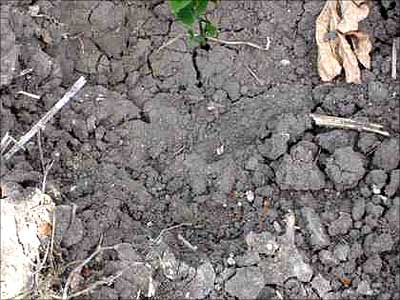
Krishnan, 62, migrated to the United States over 30 years ago and lives with his family in St Paul, Minnesota.
Like most IIT graduates, he opted for a well-paying job abroad after finishing his studies. But the severe water shortage in IIT-Madras forced him to realise the gravity of the problem. He was reminded of his childhood days when his mother had to wake up at 3 am everyday to collect the limited water supplied by the municipal corporation in Chennai.
Dr Sekhar Raghavan, a physics professor, started a door-to-door campaign in some residential areas in Chennai to popularise the concept of rainwater harvesting. He convinced over 500 homes, industries and charitable institutions to implement rainwater harvesting programmes.
The Gujarat earthquake changed his life
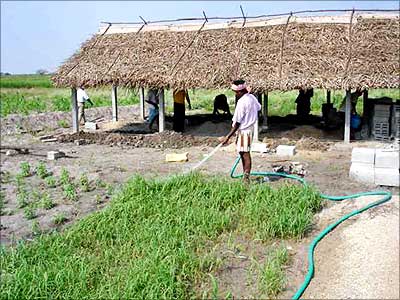
When Krishnan learnt of Dr Raghavan's efforts, he got in touch with the professor and the duo formed the Akash Ganga Trust, a citizens' action group comprising 10 persons who harvested rainwater in Chennai. Krishnan, the president of the North America IIT Alumni Association, became the overseas coordinator of the project.
He invested Rs 4 lakh (Rs 400,000) to set up a model house called the Akash Ganga Rain Centre to create awareness about rain water harvesting.
Krishnan admits that he didn't venture out to villages to spread awareness about rain water harvesting as there were no comfortable hotels for him to stay. But his attitude changed after he paid a visit to a village in Gujarat, which had been devastated by the January 26, 2001 earthquake. Krishnan and many of his friends raised money to rebuild the village.
'There is no Tamil Nadu in Chennai'
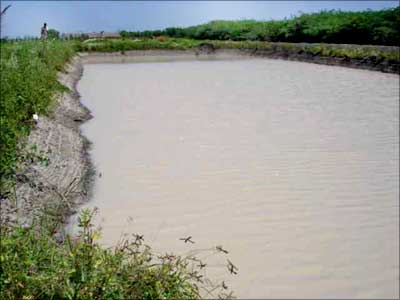
T"hat was my first visit to an Indian village," he recalls. "Those people had lost everything. There were 208 houses in the village, and 203 had collapsed. When we went there, we didn't know anything about what awaited us. I went there as a volunteer of Care International."
"As I was leaving the village, two old women told me, 'Till the earthquake happened, nobody came to help us. Nobody bothered about us'. That changed my attitude towards villages. I saw the terrible situation that villagers face in our country, and how we do nothing to improve their situation. I felt ashamed of myself," he added.
He then chose Vilathikulam in Tamil Nadu as his karmabhoomi.
Elaborating on his decision to work in a village instead of the state capital, Krishnan says, "There is no Tamil Nadu in Chennai. It's another big city. It has nothing to do with Tamil Nadu."
'Everybody warned me that nothing grows here'
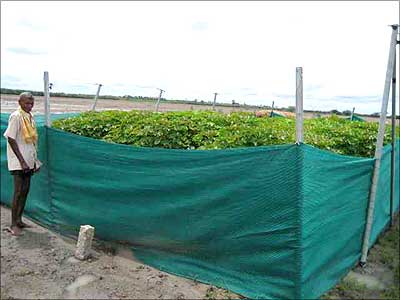
Four years ago, Ram Krishnan, along with 17 of his friends from US, went on a five-day trip to the Tamil Nadu countryside. After travelling through many dry villages, they realised that Ramanathapuram and Thoothukudi were the driest places in Tamil Nadu.
Ram Krishnan chose to start his work in Vilathikulam. "Everybody warned me that nothing grows in Vilathikulam. I was wasting my time there as it rains only nine days a year," he says.
Today, Vilathikulam has donned a new look. The villagers have collected 7 million litres of water in three ponds, which can be used for agricultural purposes, drinking as well as shared with three villages nearby.
Ram Krishnan plans to clean the water, collect in it 20 litre cans and ferry it to other villages in a bullock cart! Vilathikulam has sufficient water supply till the next monsoon.
'Villagers are not happy with plentiful harvest'
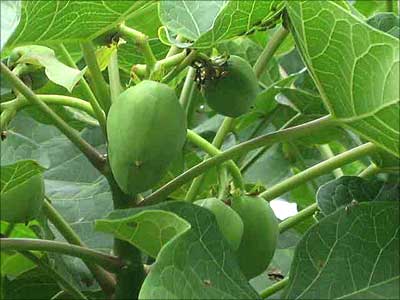
Ram Krishnan also plans to build a warehouse to store the grains produced by the farmers.
"On the day of the harvest, farmers don't get anything for themselves. The entire grain is under debt to the bank. So, a plentiful harvest is bad news for them because the price goes down. We city dwellers are happy with a plentiful harvest but they are not. They can store half of their harvest in the godowns, so that they can reap the benefits," he explained.
Ram Krishnan has also started a community centre -- the Bharatiyar Community Centre -- for the villagers, where farmers are taught various things including organising health camps, Self Help Groups, improving agricultural production etc. IIT engineer-turned-farmer R Madhavan is helping him in this endeavour. At the centre, farmers also try out the methods adopted by Madhavan for first-hand knowledge of new agricultural methods.
'You don't need a Tata or Birla to help a village'
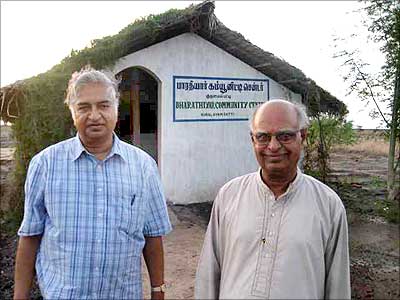
Ram Krishnan visits Vilathikulam four times in a year to check on the work done by villagers. "It is worth a million dollars to see a smile on the face of a child or an old woman. When they welcome you, a total stranger, like a part of their family, you feel so happy," he adds on an emotional note.
Recalls Ram Krishnan, "On December 22, after the PAN IIT conference, we took a group of people to many villages including Madhavan's village. Madhavan's efforts touched one IITian's heart so much that he wrote to me. He wanted to help a village."
He urges the youth to "reach out and understand Indian villages."
"It is simple. You don't need a Tata or Birla to help a village, even one person can do that. We need many, many people to change the face of Indian villages. Youngsters do not have to wait till their hair turns grey," he says.
Akash Ganga - RWH : Rain Centre
What is Akash Ganga Chennai?

Akash Ganga Chennai started in July 2001 with active participation by about ten citizen volunteers in Chennai. The group's objective is to promote Rain water harvesting in India. Since inception, the group has conducted several seminars, printed and distributed pamphlets, conducted training sessions for builders and masons. Today, there are over 100 people in the group and it is growing.
Early on, the group realized that their cause would be more effectively spread if they had a model installation that people can look at. We lacked a facility where we could take the citizen or homeowner and show the rain water harvesting system in action. This need was the birth of the rain centre. Today, after several months of effort, the rain centre is a reality. For information on what is available at the rain centre please browse this website. And please take a virtual tour of the rain centre.
The Rain Centre!
The rain centre is a model house with all forms of rain water harvesting (RWH) ideas relevant to Chennai. Chennai residents (and others) can take a tour of the facility to see the RWH systems in action. Seminars specific to builders, masons, companies, school children, and home owners alike will be offered.
The rain centre is located at No 4, Third Trust Link Street, Mandavelipakkam, Chennai 600 028. Work began on this centre in April 2001 and is expected to be ready by May 2002.
The rain centre is intended to be a museum and a laboratory rolled into one. As a museum, it is intended to showcase how an installed RWH system works. Interested people can take our tours, visit the various rooms in the house, see exhibitions on RWH, get pamphlets, and buy books on RWH. As a laboratory, it is intended, to demonstrate a working version of the RWH. We intend to collect and display statistics of how much rain water has been accumulated over time. We also intend to have a water testing facility on site wherein people can test the purity of water.
For a virtual tour of the house, start with Introduction to the rain centre.
Next time, as you are strolling along in the city, look for our telltale sign shown below.
What is Rain Water Harvesting (RWH)?

Rain water harvesting is simply the concept of collecting the rain water that falls over the roof over which you live to be reused for day-to-day water needs. For a more exhaustive description of rain water harvesting, please visit our sister site on the subject: Rain water harvesting - Akash Ganga Chennai
The concept is endorsed by the Centre for Science and Environment (CSE), New Delhi. The CSE will provide exhibits and seminar materials to be displayed in the rain centre. The rain centre is Chennai will be the first Rain Centre in India. CSE has interest in duplicating this effort in other cities.
We are constantly seeking active volunteers in our quest to eradicate the water problem in India. There are several ways in which you could volunteer:
If you are in India...
If you are willing to donate your valuable time in providing tours to visitors of the rain centre, please Sekhar Raghavan (see below) with your availability. We can provide training for you to be a tour guide.
If you have installed a RWH system, are reaping the benefits of the lack of water scarcity, and are willing to talk to us about it, write to us and we will publish it on our website.
We are seeking donations for upgrade and maintenance of the rain centre.
We are also seeking donations to install RWH systems for orphanages and in villages. To make a tax-deductible donation in India, please write a check payable to - Akash Ganga Trust- and mail to D15 Bayview Apartments, Kalakshetra Colony, Besant Nagar - Chennai 600 090.
If you are an NRI outside India...
Sponsor the installation of an RWH system at your parent's house or any other orphanage or village of your choice.
In US, we have set up a non-profit 501(c) (3) organization, approved by the IRS, called "Akash Ganga RWH" to accept fully tax deductible donations. We will accept your donations in any amount towards this Rain Centre project. Names of people contributing more than $100 will be displayed in the Rain Centre. Write the Check to: Akash Ganga RWH and mail to: 1653 20th Avenue NW, St. Paul, Minnesota 55112. We will send a proper receipt for your tax records with our sincere thanks.
Please forward the link to this site to other who may wish to contribute. If you are interested in learning more about this project, please contact one of the volunteers listed below.
If you wish to learn more...
If you wish to learn more about rain water harvesting, Akash Ganga Chennai,
or have questions about RWH installation at your place, contact one or more
of our volunteers below:
| Name | Location | Phone | |
| K. R. Gopinath | Anna Nagar, Chennai | 91 44 625-0697 | krgrainwaterharvesting@rediffmail.com |
| Sekhar Raghavan | Besant Nagar, Chennai | sekar1479@yahoo.co.in | |
| Goutam Ghosh | Chennai | gou@vsnl.net | |
| Chitra Vishwanath | Vidyaranyapura, Bangalore | 91 80 364-1690 | chitravishwanath@vsnl.com |
| Ram Krishnan | St. Paul, U.S.A. | (612)867-9425 | rkrishnan46@yahoo.com |
| Kalyan Vaidyanathan | Boston, U.S.A. | (781)641-4875 | kalyan_v@hotmail.com |
